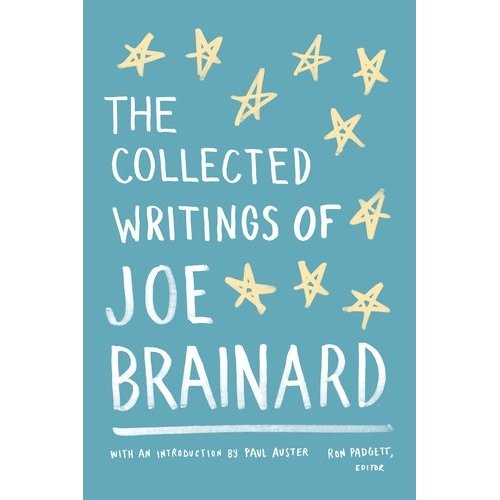Imagining page life
Observing and composing via Brainard

In the opening paragraph of his introduction to The Collected Writings of Joe Brainard, Paul Auster writes, “I Remember is inexhaustible, one of those rare books that can never be used up." I think that all of Brainard’s work shares that tireless quality—I can reread and reread and always find something new. The variety of tangible and relatable “forms” that Brainard invents lend themselves to the classroom. I usually work with some excerpt of I Remember, the prompt—“fill 2 pages with sentences that begin with “I remember...” is one I remember from my own experiences as student, and one that always produces unbelievably powerful and direct writing from my own students.
I think that one of the gifts that reading Brainard gives to students is a chance to read a text that defies normative generic definitions. In Forming, Thinking, Writing, Ann Berthoff describes the magic of the composing process as “include[ing] being puzzled, being mistaken, and then suddenly seeing things for what they probably are…you learn to make words behave the way you want them to behave and to say what you want them to say…” (3-4). Berthoff then parallels the experience of this process to that of drawing—particularly drawing without “looking at the paper.” Berthoff’s descriptions of these moments of intense observing (that are integral to the composing process) encouraged me to take a break from my usual “I Remember” prompt and turn to Brainard’s amazing “Ten Imaginary Still Lifes.”
The reason why I think I was drawn to this piece is because of the way Brainard uses candid language to depict detail and observations. And, how these observations are not predictable and for me, at least, ask me to rethink what I notice both when my eyes are open and closed.
What we did.
The loose theme of this class was “pay attention”—so, all semester we read texts that dealt with what Cathy Davidson calls “the brain science of attention.”
We began this class session by writing about the following: How do you pay attention to something? Or, what does it mean (for you) to pay attention?
We then distributed a stack of ten post-it notes to each person, and wrote one specific detail or image on each--these could be a series of descriptive words or a sentence demonstrating an observation or scene that resonated for the writer. The notes were redistributed so everyone had 10 new post-its.
I hand out copies of Brainard’s “Ten Imaginary Still Lifes.” One volunteer reads the entire piece. We then read the piece out loud sentence by sentence; every voice in the room participates. We then write about the following: What is a still life? What is an imaginary still life? When sharing our writing, most students linked “still life” to art—mentioning that a still life is realistic and detailed—a form of visual description. Someone in the room mentioned that each "Still Life" begins with "I close my eyes." So, as a class, we then decided to close our eyes and write "still lifes."
We then decided to, as a class, write “32 Imaginary Still Lifes” and the prompt was to begin each piece with “I close my eyes” and to only work with the language from the writing we did with our eyes closed + the language from the post-it notes.
We read these all out loud and then did a piece of process writing—why write an “imaginary still life”? Why is it important that we include “imaginary”?
The students’ writing was specific and clear, and they also seemed to “interpret” their own observations through “showing not telling.” And, they noticed this in their own writing. One student shared, “I always get the comment—why are you telling the reader what you’ll do, just do it!—and now I think I know how to just do it!” Another student, “I guess if you write with the idea that your reader will want to see the picture behind the words, good things happen.”
Notes
Berthoff, Ann E. Forming, Thinking, Writing. Portsmouth, NH: Boynton/Cook, 1988. Print.
Brainard, Joe. The Collected Writings of Joe Brainard. Ed. Ron Padgett. [New York, N.Y.]: Library of America, 2012. Print.
Davidson, Cathy N. Now You See It: How the Brain Science of Attention Will Transform the Way We Live, Work, and Learn. New York: Viking, 2011. Print.
Pedagogy and poetry